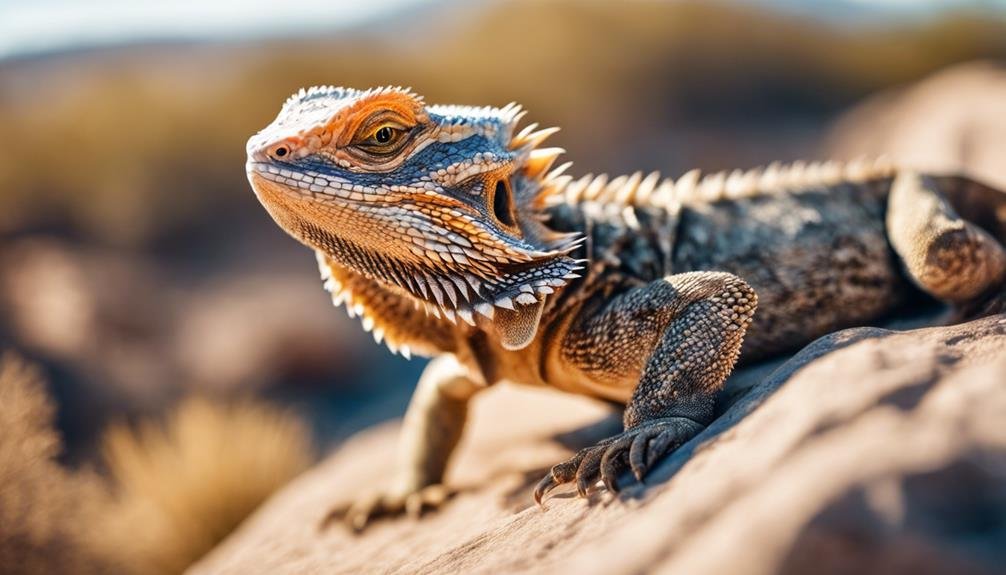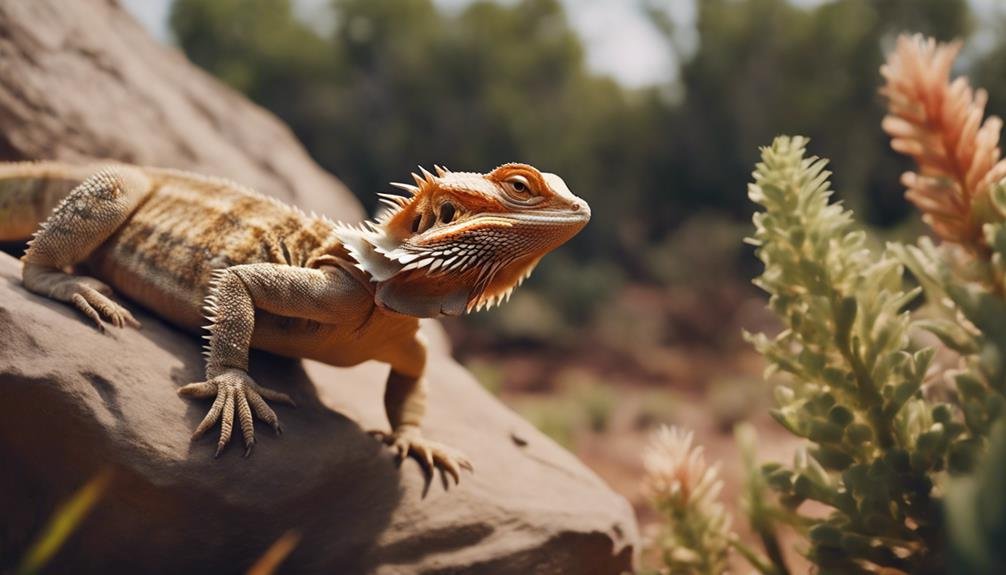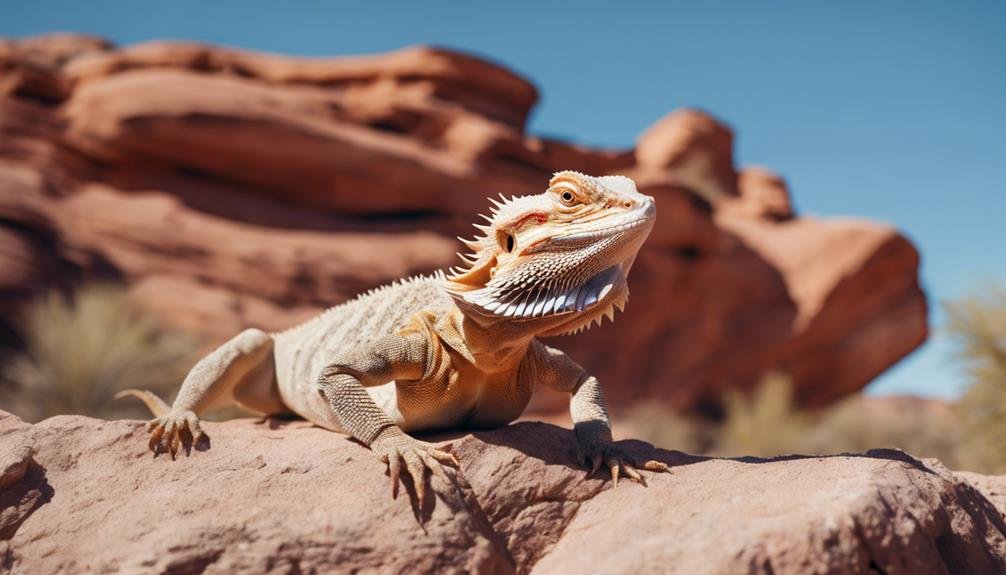You might already know that bearded dragons hail from the diverse landscapes of Australia, but have you considered how these environments shape their behaviors and survival strategies? In the wild, these reptiles navigate a mix of arid deserts and lush woodlands, each offering unique challenges and resources. Their ability to thermoregulate by basking under the intense Australian sun is essential, yet it’s just the tip of the iceberg in understanding their complex relationship with their habitat. Imagine how the specific conditions in these regions might influence other aspects of their lives, from diet to predator evasion. What might this suggest about their adaptive capabilities in changing environments?
Key Takeaways
- Bearded dragons are native to warm, arid regions of Australia, including deserts, woodlands, and scrublands.
- They thrive in environments that offer high temperatures and low humidity.
- In their natural habitat, bearded dragons frequently bask on rocks or branches to absorb necessary heat.
- Urban expansion into their territories has led to these reptiles adapting to more suburban areas.
- Australia has prohibited the export of native bearded dragons since the 1960s to protect their wild populations.
Native Habitats Explored
Bearded dragons thrive in Australia’s warm, arid regions such as deserts, woodlands, savannas, and scrublands. If you’re exploring these habitats, you’re likely to spot wild bearded dragons basking on rocks or branches. These elevated surfaces are important for them to regulate their body temperature effectively in the intense Australian heat.
Since the 1960s, Australia has banned the export of these native creatures, aiming to protect their wild populations. As a result, the wild bearded dragons you see today are flourishing in their natural settings, undisturbed by international pet trade pressures. These reptiles have also shown remarkable adaptations to urbanized areas, although they still depend on the warmth of their natural habitats for survival.
Each species of bearded dragon has adapted to a specific part of Australia’s diverse landscapes. Whether in the scrublands, where cover is sparse, or the denser woodlands, these dragons have developed unique ways of life that suit the specific conditions of their environments. This specialization helps secure their survival across the varied terrains of their native land, making each encounter with these fascinating reptiles in the wild a unique insight into their adaptive capabilities.
Adapting to Arid Climates
Understanding how bearded dragons have mastered life in arid climates can deepen your appreciation of their resilience. These hardy reptiles, native to the warm, dry regions of Australia such as deserts and scrublands, have developed remarkable adaptations to thrive in environments where others might struggle.
One key adaptation is their ability to regulate body temperature. In the scorching heat of arid climates, you’ll often find bearded dragons basking on rocks and elevated surfaces. This isn’t just for enjoyment; it’s a crucial behavior that allows them to absorb the necessary heat to stay active. Their body temperature management is essential for their survival, as it aids in digestion and overall mobility.
Moreover, bearded dragons possess the ability to change their skin color. This isn’t merely for aesthetic appeal; it’s a strategic adaptation that enables them to blend seamlessly into their surroundings. This camouflage helps them avoid predators and manage heat absorption, making it easier to maintain their body temperature in the varying extremes of their habitat.
These adaptations highlight the bearded dragon’s incredible resilience and ability to thrive in the challenging conditions of arid climates.
Typical Daily Behaviors


Throughout the day, bearded dragons engage in a variety of activities, primarily basking in the sun to regulate their body temperature. As diurnal creatures, they’re up and about when the sun shines, ensuring they get ample heat. You’ll find them sprawled on rocks or branches, soaking up the warmth they need to stay active.
Apart from basking, these reptiles love climbing. Whether it’s scaling the rugged terrains of their natural habitat or clambering onto elevated surfaces in captivity, they’re agile climbers. This behavior isn’t just for fun; it serves a critical purpose. By reaching higher ground, they can better survey their surroundings and spot potential threats or prey.
Being territorial, bearded dragons also use their climbing skills to assert dominance and claim the best sunning spots. If another dragon ventures too close, you might observe some assertive displays meant to ward off the intruder. They’re not just passive sunbathers; they actively defend their chosen territory.
Environmental Threats
How do environmental threats impact the survival of bearded dragons in the wild? You’ll find that habitat loss, illegal pet trade, predation, and diseases from internal parasites are significant challenges they face. Let’s explore these issues.
Habitat loss is primarily driven by human activities such as urban expansion and agriculture, which destroy and fragment the environments where you’d typically find bearded dragons thriving. This not only reduces their living space but also affects their food sources and shelter.
The illegal pet trade further complicates their survival. Poachers capture bearded dragons from the wild to sell them globally, severely depleting local populations and disrupting ecological balance.
Here’s how these threats stack up:
| Threat | Impact on Bearded Dragons |
|---|---|
| Habitat Loss | Reduces living space and food sources |
| Illegal Pet Trade | Depletes populations, disrupts ecology |
| Predators | Increases risk of being preyed upon |
| Internal Parasites | Weakens health, lowers survival chances |
| Environmental Degradation | Further stresses their habitats |
Predators such as birds, snakes, and mammals naturally prey on bearded dragons, while internal parasites and mites compromise their health, making survival in already tough conditions even harder. Each of these threats intertwines, creating a challenging environment for these fascinating reptiles.
Conservation Efforts


Despite these challenges, there are ongoing conservation efforts aimed at protecting bearded dragons in their natural habitats. These initiatives focus primarily on destocking and predator control within various reserves. Conservationists are actively promoting the growth of native vegetation, which is vital for maintaining the environment where these creatures thrive.
Habitat loss and degradation, largely due to human activities, remain significant threats to bearded dragons. To combat this, efforts are being ramped up to educate the public on the importance of preserving these habitats, not only for bearded dragons but for all Australian wildlife. The illegal pet trade also poses a serious risk, stripping the wild of these unique lizards. Conservation groups are working tirelessly to monitor and regulate this trade, ensuring that populations aren’t decimated.
You can play a part too. Supporting these conservation efforts through donations or volunteer work can make a big difference. Every contribution helps safeguard that bearded dragons continue to flourish in the wild, safeguarding their future and the biodiversity of Australia. Remember, every action counts in the fight against habitat loss and the illegal pet trade.
Conclusion
As you’ve learned, bearded dragons call the rugged terrains of Australia home, thriving in arid environments from deserts to scrublands. These resilient reptiles adapt impressively to both the harsh climates and urban encroachments.
Observing their daily behaviors, like basking for warmth, underscores their survival tactics. However, they face significant environmental threats. Supporting conservation efforts is essential to guarantee that bearded dragons continue to flourish in their native habitats for generations to come.

